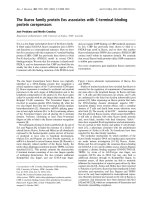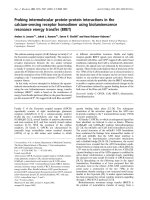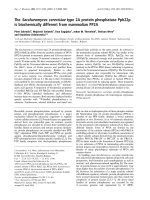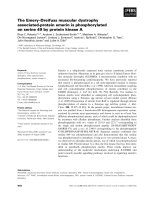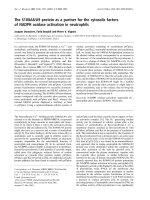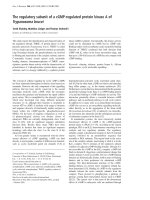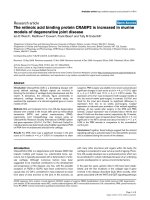Báo cáo y học: "The Hedgehog protein family" ppsx
Bạn đang xem bản rút gọn của tài liệu. Xem và tải ngay bản đầy đủ của tài liệu tại đây (454.68 KB, 9 trang )
Genome
BBiioollooggyy
2008,
99::
241
Protein family review
TThhee HHeeddggeehhoogg pprrootteeiinn ffaammiillyy
Thomas R Bürglin
Address: Department of Biosciences and Nutrition, Karolinska Institutet, and School of Life Sciences, Södertörn University, Hälsovägen 7,
SE-141 57 Huddinge, Sweden. Email:
SSuummmmaarryy
The Hedgehog (Hh) pathway is one of the fundamental signal transduction pathways in animal
development and is also involved in stem-cell maintenance and carcinogenesis. The
hedgehog
(
hh
)
gene was first discovered in
Drosophila
, and members of the family have since been found in
most metazoa. Hh proteins are composed of two domains, an amino-terminal domain HhN,
which has the biological signal activity, and a carboxy-terminal autocatalytic domain HhC, which
cleaves Hh into two parts in an intramolecular reaction and adds a cholesterol moiety to HhN.
HhC has sequence similarity to the self-splicing inteins, and the shared region is termed Hint.
New classes of proteins containing the Hint domain have been discovered recently in bacteria
and eukaryotes, and the Hog class, of which Hh proteins comprise one family, is widespread
throughout eukaryotes. The non-Hh Hog proteins have carboxy-terminal domains (the Hog
domain) highly similar to HhC, although they lack the HhN domain, and instead have other
amino-terminal domains. Hog proteins are found in many protists, but the Hh family emerged
only in early metazoan evolution. HhN is modified by cholesterol at its carboxyl terminus and by
palmitate at its amino terminus in both flies and mammals. The modified HhN is released from
the cell and travels through the extracellular space. On binding its receptor Patched, it relieves
the inhibition that Patched exerts on Smoothened, a G-protein-coupled receptor. The resulting
signaling cascade converges on the transcription factor Cubitus interruptus (Ci), or its mammalian
counterparts, the Gli proteins, which activate or repress target genes.
Published: 19 November 2008
Genome
BBiioollooggyy
2008,
99::
241 (doi:10.1186/gb-2008-9-11-241)
The electronic version of this article is the complete one and can be
found online at />© 2008 BioMed Central Ltd
GGeennee oorrggaanniizzaattiioonn aanndd eevvoolluuttiioonnaarryy hhiissttoorryy
Hedgehog (Hh) proteins are composed of two distinct
domains, the amino-terminal ‘Hedge’ domain (HhN), and
the carboxy-terminal ‘Hog’ domain (HhC) (Figure 1 and
Box 1). The founding member of the hh gene family was first
discovered in genetic screens in Drosophila melanogaster
[1] and, once the gene was cloned [2-4], vertebrate members
were soon found [5-7]. Drosophila has a single hh gene,
mammals have three paralogous genes, called Sonic Hedge-
hog (Shh), Indian Hedgehog (Ihh), and Desert Hedgehog
(Dhh), and the cnidarian Nematostella vectensis has two
paralogous hh genes, Nv_HH1 and Nv_HH2 [8]. The hh
gene family is present throughout the Eumetazoa, although
it has been lost in some nematodes. For example,
Caenorhabditis elegans has no hh gene but has other genes
related to hh via the Hog domain. These hh-related genes
have been grouped into different families, such as Warthog
(wrt), Groundhog (grd), and Quahog (qua), and are charac-
terized by having amino-terminal sequences distinct from
HhN [9,10].
Soon after the discovery of the fly and vertebrate Hh
proteins, it was noticed that their carboxy-terminal auto-
proteolytic domains were similar in sequence to the self-
splicing inteins [11]. Inteins are protein sequences that
autocatalytically splice themselves out of longer protein
precursors - analogous to introns - and ligate the flanking
regions into a functional protein [12,13]. The determination
of the X-ray structure of the Drosophila HhC domain
confirmed this similarity, and the region of similarity was
named the Hint module [14] (see Figure 1). More recently,
new classes of Hint-containing proteins with various types of
processing activity have been recognized in bacteria and
eukaryotes [10,13,15,16] (Figure 2). Intein-containing genes
are present in all three kingdoms of life, but Hog genes and
Vint genes - a novel class of proteins sharing a VWA domain
(von Willebrand factor type A domain) and a Hint domain -
are known only from eukaryotes at present (Figure 2).
Initially, Hog genes, primarily members of the Hh family,
were found only in metazoa, but they have recently been
found in many different branches of protists [10,13,17,18]
(Figure 3). This widespread distribution indicates that the
Hog domain must be of ancient origin and have emerged
early in eukaryote evolution. Hog genes are absent in higher
plants and several fungal clades, which is presumably due to
/>Genome
BBiioollooggyy
2008, Volume 9, Issue 11, Article 241 Bürglin 241.2
Genome
BBiioollooggyy
2008,
99::
241
FFiigguurree 11
Structural features of Hh proteins.
((aa))
Signal peptide sequence for protein
export (SS, yellow), the amino-terminal signaling domain (HhN, green), and
the autocatalytic carboxy-terminal domain (HhC, black) are indicated. Both
HhN and HhC domains are also found in proteins other than the Hh family,
and are therefore globally referred to as ‘Hedge’ and ‘Hog’, respectively.
The Hog domain itself can be separated into two regions; the first two-
thirds shares similarity with self-splicing inteins, and this module has been
named Hint, whereas the carboxy-terminal third binds cholesterol in Hh
proteins and has been named the sterol-recognition region (SRR) [14]. In
Hog proteins other than Hh, that is, Hh-related proteins, this region is
referred to as ARR (adduct recognition region) [21], as the nature of the
adduct is not known.
((bb))
Intramolecular autoprocessing of Hh. Acids and
bases assisting in catalysis are not shown (figure adapted from [14,70]).
HhC
HhN
N
O
S
H
H
HhN
N
O
S
H
2
O
H
H
N
S
H
2
Cholesterol
N-S acyl
shift
HhN
O
O
HhC
HhC
Hint SRR/ARR
Hedge Hog
HhN
HhC
(a)
(b)
Cys
SS
Box 1. Terminology
Hint domain/module: an autoproteolytic domain/module originally described in Hedgehog proteins and self-
splicing inteins. The Hint-containing group of proteins encompasses several distinct classes, such as inteins, the Hog
proteins (including the Hh family), as well as as Bil-A, Bil-B, and Vint.
Hog proteins: class of Hint proteins with a distinct subtype of Hint domain and a carboxy-terminal ARR found in
many eukaryotic phyla. The Hint and ARR regions together comprise the Hog domain.
Hedgehog (Hh): one family of Hog proteins found in eumetazoa, composed of an amino-terminal Hedge (HhN)
domain and a carboxy-terminal Hog (HhC) domain.
Hedge domain: comprehensive term for the amino-terminal domain of Hh proteins and of Hedgling proteins (which
lack a Hog domain).
HhN and HhC: amino-terminal and carboxy-terminal domains specifically of Hh family proteins.
Hh-related genes: a comprehensive term used for those Hog proteins that have amino-terminal domains different
from that of Hh, for example, the Quahog, Warthog, and Groundhog families in nematodes.
SRR: sterol-recognition region, the cholesterol-binding site of HhC.
ARR: adduct recognition region in the Hog domain of Hh-related proteins
FFiigguurree 22
Distribution of Hint superclass genes in the three domains of life. Hint
genes can be divided into several different classes: inteins; Bil-A (bacterial
intein-like genes type A); Bil-B; a new class referred to here as Bil-C
[10,13]; Vint (VWA domain and Hint domain proteins) [10]; and Hog.
Hint superclass
Inteins
Inteins
Inteins
Bil-A
Vint
Hog
Eubacteria
Eukaryotes
Archaea
Bil-B
Bil-A
Bil-C
gene loss. Many of the protist Hog proteins, as well as the
metazoan non-Hh Hog proteins - referred to as Hh-related
proteins - have putative secreted domains upstream of the
Hog domain [10]. In most cases these upstream regions show
conservation only with related Hog genes within the same
phylum, suggesting a gradual evolution of the amino-terminal
regions within each phylum. In a few instances, such as the
fungus Glomus mosseae [17], the choanoflagellate Monosiga
ovata [18], and the sponge Amphimedon queenslandica [19],
the Hog domain is fused to other well-conserved domains,
indicative of a merging of two distinct domains.
The Hedge domain seems to be of more recent origin. It has
been found in sponges and Cnidaria in a large extracellular
membrane protein called Hedgling [19]. In addition to the
Hedge domain at the amino terminus, Hedgling contains
many additional domains, such as a VWA domain and
numerous cadherin repeats, but lacks a Hog domain [10,19].
A second, divergent fragment of a Hedge domain has been
found in the sponge Oscarella carmela that also seems to
lack a Hog domain [10,20]. At present, no hh genes have
been found in sponges, but they are present in Cnidaria. Two
scenarios can be envisaged for the emergence of Hh proteins
proper (Figure 4). One is that the Hedge domain evolved
from a secreted amino-terminal domain already associated
with the Hog domain. Hedgling is then derived from Hh by a
‘split’ of Hedge from Hog before the emergence of sponges.
The other is that the Hedge domain evolved in an extra-
cellular protein such as Hedgling. During the emergence of
Eumetazoa, the Hedge domain ‘fused’ with a Hog protein to
give rise to Hh. Examples of both domain split and loss and
domain-merging events are documented for Hog proteins,
and therefore do not help to discriminate between alter-
native scenarios.
/>Genome
BBiioollooggyy
2008, Volume 9, Issue 11, Article 241 Bürglin 241.3
Genome
BBiioollooggyy
2008,
99::
241
FFiigguurree 33
Consensus phylogenetic tree of eukaryotes. The branches where Hog domain containing proteins are found are indicated with red dots. With permission
from Sandra Baldauf, (see, also [71]).
Fungi
Microsporidia
Animals
Sponges
Choanoflagellates
Mesomycetozoa
Nucleariids
Vahlkampfiid amoebas
Euglenids
Diplomena
Core jakobids
Trypanosomes
Leishmanias
Diplomonads
Parabasalids
xi
t
s
a
m
i
r
T
Acrasid slime molds
Stachyamoeba
Carpediomonas
Oxymonads
Flabellinid amoebas
Tubulinid amoebas
Archamoebae
Dictyostelid slime molds
Plasmodial slime molds
Ciliates
Marine group II
(Syndineales)
Marine group I
Colpodellids
Apicomplexans
Dinoflagellates
Perkinsus
Radiolarians
Chlorarachnia
Desmothoracids
Plasmodiophorids
Cercomonads
Foraminiferans
Radiolarians
Red algae
Glaucophyte algae
Prasinophyte algae
Chlorophyte algae
Ulvophyte algae
Charaphyte algae
Land plants
Other algae with
chlorophylls a and c
Labyrinthulids
Opalinids
Diatoms
Oomycetes
Brown algae
Bicosoecids
Cryptophytes
Haptophytes
Telonemids
Amoebozoa
Archaeplastida
Rhizaria
Alveolates
Stramenopiles
Discicristates
Excavates
Opisthokonts
Possible root
Very recent findings have led to a revised understanding of
the evolution of hh genes and the hh-related genes in
metazoa. In Drosophila and vertebrates only hh genes are
found, but both hh and hh-related genes are present in the
Cnidaria, nematodes and also the Lophotrochozoa [8,10]. I
have searched the genome sequences of two lophotrocho-
zoan species, the limpet Lottia gigantea and the polychaete
worm Capitella I ECS-2004, and retrieved one hh gene and
six hh-related genes from L. gigantea and one hh gene and
one hh-related gene from Capitella. These sequences have
been combined with previously published sequences to
generate a new phylogenetic tree based on the Hog domain
(Figure 5). The most interesting observation from the tree is
that the hh-related genes Cap_213608 and Lg_236513 form
a clade, and these two sequences also share sequence
similarity just upstream of the Hog domain. Therefore, it
seems likely that a new hh-related gene family, which I refer
to as ‘Lophohog’, exists in the Lophotrochozoa and developed
in parallel with Hh. On the basis of this observation, the
following model could be proposed for the evolution of hh
and hh-related genes in metazoa (see Figure 4). I suggest that
at least one hh and one hh-related gene existed at the origin
of the Eumetazoa, giving rise to the hh and hh-related genes
in the Cnidaria, the Lophotrochozoa, and nematodes. In
Drosophila and deuterostomes the hh-related gene was lost,
whereas in the nematode branch leading to C. elegans, hh
was lost. The most radical alternative scenario would be that
the hh-related genes in Cnidaria, Lophotrochozoa, and
nematodes are all derived independently from a hh gene in
each phylum. Intermediate scenarios, where hh-related genes
evolved from a hh gene only in one or two phyla, could also be
possible. Phylogenetic analysis does not give definitive
answers yet, but may resolve the question in the future, when
additional genomes are sequenced.
/>Genome
BBiioollooggyy
2008, Volume 9, Issue 11, Article 241 Bürglin 241.4
Genome
BBiioollooggyy
2008,
99::
241
FFiigguurree 44
One possible scenario for the evolution of
hh
and
hh
-related genes in metazoa. Different phylogenetic branches are outlined, and gene families known at
present are shown. Dotted lines indicate uncertain evolutionary connections. Hedgling genes are currently known only from sponges and Cnidaria
[8,10,19]. The Hh family could have originated in two possible ways.
((aa))
The Hedge domain evolved concomitantly with the Hog domain from a protist
Hog protein before the emergence of the Metazoa. A duplication of the Hedge domain and merger with an extracellular protein gave rise to the Hedgling
gene.
((bb))
No
hh
gene existed at the emergence of sponges. The Hedge domain of a Hedgling gene duplicated and merged with a Hog gene to give rise to
hh
in early Eumetazoa. Cnidaria, Lophotrochozoa and nematodes contain both Hh as well as other Hog family genes. The phylogenetic analysis cannot
unequivocally resolve whether these other families originated from a single ancestor in Eumetazoa - as shown here with dotted lines - or whether, at
least in some phyla, duplication and divergence from a
hh
gene gave rise to new families in particular phyla.
Ground
Wart
TT
Grl
Chromadorea
Enoplea
Nematodes
Arthropods
Hedge
Hedge
Qua
Hedge
Deuterostomes
Hedge
Cnidaria
Qua
Shh
Hedge
Sponges
Enop
Hedge
Ecdysozoa
Lophotrochozoa
Hedge
Hedge
Dhh
Ihh
vWA
Hedge
CA
Hedgling
vWA
Hedge
CA
Hedgling
laccase
laccase
laccase
(a)
(b)
Hedge
vWAHedge CA
Hedgling
Split
vWA
Hedge
CA
Hedgling
?
Hedge
Merge
?
?
Lopho
?
/>Genome
BBiioollooggyy
2008, Volume 9, Issue 11, Article 241 Bürglin 241.5
Genome
BBiioollooggyy
2008,
99::
241
FFiigguurree 55
Neighbor-joining phylogenetic tree of eukaryote Hog domain protein sequences. The Hh, Groundhog (Grd), Warthog (Wrt), Quahog (Qua), and new
Lophohog families are indicated. Sequence names are color-coded according to phyletic divisions, except for sponges. Chromadorea and Enoplea are two
major nematode divisions. Protist is loosely used to encompass all non-metazoans. The Hint domains of Vint proteins were used as outgroup and
bootstrap values ≥ 40 % are shown. Most of the sequences and the analysis methods are described in [10]. Additional sequences were added to this
analysis from sponges [19], and BLAST searches were carried out at JGI [72] of the genomes of
L. gigantea
and
Capitella
I ECS-2004. From
Capitella
I
ECS-2004 one
hh
and one
hh
-related gene were retrieved, and from
L. gigantea
one
hh
and six other Hog genes were retrieved.
Capitella
Cap_213608
and
L. gigantea
Lg_236513, which encodes an export signal peptide, form a clade, although not with high bootstrap significance. Interestingly, this clade
clusters with the Cnidarian
hh
-related genes - although bootstrap values are insignificant. Five
L. gigantea
Hog genes (Lg_173620, Lg_173619, Lg_237232,
Lg_FC606200, Lg_229767) form a distinct clade, but these genes are very divergent from the Hog domains of the other metazoan genes. These genes
encode only a few residues upstream of the Hog domain (7-15), and lack an export signal peptide. This unusual structure is confirmed by multiple
expressed sequence tags (ESTs) for each gene. Do these genes represent a highly divergent form of Hog-only proteins in this gastropod, or do they stem
from another organism, perhaps some ciliated protozoan parasite found in
L. gigantea
[73]? More analysis will be necessary to resolve this.
pOs_AK110392
XC_Shog2
rGj_Hog
rGc_Hog1
rPy_Hog
rPy_Hog2
85
84
rGc_Hog3
rCc_Hog2
43
rCc_Hog
49
rPh_Hog
58
pSm_Hog
pPp_Hog
hPh_Hog1
hPh_Hog2
hPh_Hog3
100
100
100
Lg_229767
Lg_FC606200
Lg_237232
Lg_173619
Lg_173620
100
100
99
91
82
58
41
Mo_hoglet
jJl_Hog1
crGt_Hog1
66
fGm_GmGIN1
Aq_lachogB2
Aq_hogB1
Aq_lachogC1
Aq_lachogA1
57
Aq_lachogA2
54
Pv_Hh
Lg_Hh
Ob_Hh
Es_Hh
100
100
100
95
Sp_hh
Lv_hh
Gb_Hh
Gm_Hh
Bf_AmphiHh
40
Mm_Sh h
Hs_SHH
Dr_shha
Dr_shhb
100
84
Mm_Dhh
Hs_DHH
86
100
Mm_Ihh
Hs_IHH
61
100
Dr_ihha
Dr_ihhb
57
93
Tr_fhh
100
Dh_Hh
Dm_Hh
Ag_Hh
100
At_Hh
97
Cap_Hh
42
Dr_dhh
XC_Hh
Ts_hh
Nv_HH2
Nv_Hint3
Acm_DY579185
Cap_213608
Lg_236513
97
57
Nv_Hint1
Nv_Hint2
84
1
Nv_HH1
aKm_Hog
aAt_Hog
Ts_Xhog3
aAc_Hog
100
aCp_Hog
aCm_Hog
Hm_CO905822
cBn_Hog
100
40
XC_Shog1
XC_Shog1b
XC_XHog4
100
XC_Thog
50
XC_Xhog5
91
Ts_Xhog2
45
Ts_Xhog1
52
Cb_qua-1
Cr_qua-1
Ce_qua-1
95
Bm_qua-1
100
XC_Xhog1
Ts_qua-1
100
89
XC_Xhog2
XC_Xhog3
51
100
Ce_grd-1
Cb_grd-1
Ce_grd-2
100
Ce_grd-11
Ce_hog-1
Cb_hog-1
100
100
Ce_wrt-1
Cb_wrt-1
Ce_wrt-6
Cb_wrt-6
Bm_wrt-6
100
Ce_wrt-4
Cb_wrt-4
Ce_wrt-7
Ce_wrt-8
98
100
100
100
100
40
100
73
67
92
48
100
Sponge
Hh
WRT
GRD
QUA
Vint
0.05
Chromadorea
Enoplea
Protist
Cnidaria
Lophotrochozoa
Deuterostomes
Arthropoda
Lophohog
CChhaarraacctteerriissttiicc ssttrruuccttuurraall ffeeaattuurreess
Hh proteins are synthesized as precursor proteins (about
400-460 amino acids long) and comprise several different
motifs and domains: a signal peptide for protein export, a
secreted amino-terminal HhN (Hedge) domain that acts as a
signaling molecule, and an autocatalytic carboxy-terminal
HhC (Hog) domain that contains a Hint module (see Figure 1).
Multiple sequence alignments of the HhN and HhC domains
defining the conserved residues and features have been
presented in [10]. HhC binds cholesterol in the sterol-
recognition region (SRR) [21]. The catalytic activity of the
Hint module cleaves Hh into two parts and adds the choles-
terol moiety to the carboxyl terminus of HhN (Figure 1b).
The structure of Drosophila HhC has been determined using
X-ray crystallography and shows a high congruence with
that of inteins [14]. The structure is globular, composed of β
strands, and starts with a cysteine residue critical for auto-
processing (Figure 1b). The nematode Hh-related protein
WRT-1 was shown to be autoprocessed like Hh [22]. Given
that the critical residues of the active site of HhC are well
conserved among Hog proteins [10,14], it can be assumed
that most, if not all, are autoprocessed. However, it is not
known what adduct binds to the adduct-recognition region
(ARR) of Hh-related proteins. Intriguingly, the ARR regions
of some of the protist Hog proteins contain motifs conserved
with the Hh SRR [10], suggesting that sterol binding might
be an ancient feature.
The structure of the HhN domain of mouse Shh has also
been determined [23]. It is a relatively globular domain with
two antiparallel α helices and several β strands wrapping
one face of the two helixes. Although it was found to have a
potential catalytic site, no enzymatic activity has been un-
covered so far [24]. In addition to the cholesterol modifi-
cation, the HhN domain is also modified at its amino terminus
by palmitate through the action of a transmembrane
acyltransferase, named Skinny hedgehog (Ski, also known as
Rasp) in Drosophila [25], and hedgehog acyltransferase
(HHAT) in mammals [26]. Because of these lipid modifi-
cations, the modified HhN domain (M-HhN) can form
multimeric complexes [27,28] and can interact with lipo-
proteins [29]. Drosophila Ihog (interference hedgehog) and
its mammalian orthologs Cdo and Boc are M-HhN-inter-
acting proteins that are required for normal Hh signaling.
They are type I integral membrane proteins with four extra-
cellular immunoglobulin-like domains and two extracellular
fibronectin type III domains. Biochemical and structural
studies of complexes of Drosophila HhN and Ihog show that
heparin induces dimerization of Ihog, a prerequisite for
high-affinity interactions between M-HhN and Ihog [30].
Biochemical and structural studies of complexes of mouse
ShhN and Cdo revealed a different mode of binding, where a
calcium-binding site in ShhN is important for the interaction
[31]. Therefore, although the structures of fly HhN and
mouse ShhN are conserved, the mode of interaction is not
necessarily conserved in evolution.
LLooccaalliizzaattiioonn aanndd ffuunnccttiioonn
An export signal peptide targets newly synthesized Hh to the
endoplasmic reticulum, where autoprocessing, as well as
palmitoylation, of the HhN domain occurs [26,28]. The
modified HhN is released from the cell with the aid of the 12-
pass transmembrane protein Dispatched (Disp). Once released
into the extracellular environment, M-HhN interacts with a
number of different proteins: the heparan-sulfate proteo-
glycan Dally-like (Dlp), and the proteins Ihog and growth-
arrest-specific 1 (Gas1) are positive regulators of Hh signal-
ing, whereas Hh-interacting protein (Hip) acts as a negative
regulator by sequestering M-HhN. The lipid modification of
HhN as well as the extracellular protein interactions influ-
ence its extracellular movement and ensure correct short-
and long-range signaling (see, for example, [28]).
The key function of M-HhN as an extracellular signal is to
inhibit the activity of the receptor Patched (Ptc), a 12-pass
transmembrane protein. Ptc is closely related to Disp and
shares similarity with the bacterial family of resistance-
nodulation division (RND) proton pumps that transport small
molecules across membranes. Numerous reviews deal with
the biological function of the Hh pathway and its components
[32-52]. Figure 6 shows a summary of the pathway composed
from Drosophila and mammalian data (although a number of
important differences exist between the pathways in these two
groups of organisms). Briefly, in the absence of M-HhN
binding, Ptc represses a signaling pathway that acts through
Smoothened (Smo), a seven-pass G-protein-coupled receptor.
Smo is negatively regulated by pro-vitamin D3, and is
positively, but indirectly, regulated by oxysterols (oxygenated
derivatives of cholesterol) [53-55]. 7-Dehydrocholesterol
reductase, which converts pro-vitamin D3 into cholesterol, is
also a regulator of Hh signaling [56]. Another important
aspect of Smo activity is its subcellular localization. When M-
HhN binds to Ptc, the complex is internalized while Smo
translocates to the cell membrane or - in mammals - to the
primary cilia. Localization of Smo to the primary cilia is a
fundamental requirement for the pathway to be active, and in
the absence of M-HhN, Ptc inhibits this localization [57]. How
exactly Ptc inhibits Smo is still not clear and numerous models
are being contemplated (see, for example, [38,41,52]).
Because of the similarity of Ptc to bacterial transporters, Ptc
could secrete a pro-vitamin D3 or related molecule to inhibit
Smo. Activated Smo is phosphorylated and signals via a
cascade of microtubule-associated proteins to the nucleus,
where the transcription factor Cubitus interruptus (Ci) in
Drosophila or its mammalian counterparts, the Gli trans-
cription factors, activate or repress target genes. Among the
many target genes regulated by mammalian Gli1 are those for
Ptc and Gli1 themselves. This results in feedback loops in
which upregulation of Ptc leads to negative feedback, whereas
upregulation of Gli1 leads to positive feedback.
In animal development, the secreted M-HhN moiety
functions as a morphogen. The Hh signaling pathway plays
/>Genome
BBiioollooggyy
2008, Volume 9, Issue 11, Article 241 Bürglin 241.6
Genome
BBiioollooggyy
2008,
99::
241
many important roles in development, including conferring
segment polarity on the body segments and patterning the
wing in Drosophila, and patterning the neural tube in
mammals [39,48,58]. Hh is also required for stem-cell
maintenance, and mutations in the pathway lead to cancer.
Increased activity of the pathway causes basal cell carcinoma
and medulloblastoma [37,59-63]. For example, insufficient
Ptc function leads to Gorlin syndrome in humans, one
feature of which is an increased risk of basal cell skin cancer.
In mammals, Shh, Dhh, and Ihh have partially redundant
functions. Shh is the most widely expressed of the three
paralogs, and regulates development from embryo to adult.
Key roles are in patterning the neural tube: Shh is first
expressed in the notochord, and later in the floor plate of the
neural tube, where it produces a gradient of activity in the
ventral neural tube. Shh is also expressed in the zone of
polarizing activity of the limb buds and is important for limb
and digit formation. Other roles of Shh include inner ear,
eye, taste bud, and hair follicle development. Ihh is expressed
in the primitive endoderm and is required for bone growth
and pancreas development. Shh and Ihh both play roles in
cardiovascular development. Dhh is expressed in the gonads,
and Dhh-mutant males are sterile [39,48,64].
FFrroonnttiieerrss
Despite substantial insights into the Hh signaling pathway,
there are still many gaps in our understanding. How, and in
/>Genome
BBiioollooggyy
2008, Volume 9, Issue 11, Article 241 Bürglin 241.7
Genome
BBiioollooggyy
2008,
99::
241
FFiigguurree 66
A simplified Hh signaling pathway, constructed from combined
Drosophila
and mammalian data. Hh is targeted to the endoplasmic reticulum by its signal
peptide, is palmitoylated at its amino terminus by Rasp/Skinny Hedgehog (Ski), and autoprocessed. Lipidated HhN (M-HhN) is released by Dispatched
(Disp) and forms multimers or associates with lipoproteins (LP) in the extracellular environment [32]. A number of molecules can interact with M-HhN
and propagate or modulate its trafficking: the Dally-like protein (Dlp), which is modified by the heparan sulfate (HS) polymerases Tout-velu (Ttv), Sister
of tout-velu (Sotv), and Brother of tout-velu (Botv), all members of the EXT family; the Hedgehog-interacting protein (Hip); and the Growth-arrest-
specific 1 (Gas1) protein. Hip and Gas1 are not present in
Drosophila
. Megalin (Meg) is most probably involved in the recycling of M-HhN. Ihog is
thought to function as co-receptor for M-HhN. M-HhN acts as an antagonistic ligand that represses the function of the receptor Patched (Ptc), a 12-
transmembrane protein related to Disp. Binding of M-HhN to Ptc results in internalization. Smoothened (Smo) is a seven-pass membrane receptor, which
is key for the transmission of the signal to the nucleus in the Hh pathway. Smo is inhibited by Ptc when not bound by M-HhN. When the inhibitory
function of Ptc is released by M-HhN, Smo can translocate to the plasma membrane or - in mammals - to the primary cilium, and active Smo is
phosphorylated (red P). Ptc may secrete pro-vitamin D3 or related compounds (D3) to inhibit Smo. Conversely, oxysterols (Oxy) can indirectly activate
Smo [52,55]. The Hh pathway downstream of Smo displays some important differences between
Drosophila
and mammals. In
Drosophila
, when Smo is
active, the signal passes through a complex comprising the kinesin-like molecule Costal 2 (Cos2), Fused (Fu), Suppressor of fused (Su(fu)) and Cubitus
interruptus (Ci), leading to the release of Ci, which can then enter the nucleus to activate transcription. When Smo is inhibited, the Cos2/Fu/Su(fu)/Ci
complex remains associated with microtubules, Ci is phosphorylated and is cleaved by Cos2. The Ci fragment now acts as a transcriptional repressor. In
mammals, the targeting of Smo to primary cilia is essential for signal transduction. No obvious equivalents of Cos2 and Fu exist in mammals. Instead,
Su(fu) has a more prominent role in inhibiting the pathway. Gli1, Gli2, and Gli3 are the mammalian homologs of Ci; Gli1 and Gli2 activate transcription
when Smo is active, whereas Gli3 is processed and becomes a repressor when Smo is inhibited. A number of components in the pathway, in particular
downstream of Smo, are not shown in this figure.
Ski
Disp
Hip
GAS1 Dlp
Ttv
Sotv
Bot v
HS
HS
Auto-
processing
Hh
Signaling cell
Multimeric
form / LP
bound
Ci
Ci
ON
Ptc
OFF
Ci
Smo
Receiving cell (+Hh)
Ci
Co
Fu
Smo
Meg
Receiving cell (-Hh)
Ptc
lhog
Processing
Repressor
Ci
Co
Fu
Su(fu)
Ci
Co
Fu
Activator
D3
oxy
ptc,
ptc,
Smo
-
?
P
+
-
Smo
Su(fu)
Su(fu)
which forms, the M-HhN morphogen travels from the
signaling cells to the target cells requires further investi-
gation. Obviously, the number of potential interactors in the
extracellular matrix and extracellular space is vast, and any
changes therein could influence how M-HhN propagates.
And could the M-HhN domain potentially have functions
other than to regulate the Ptc-Smo interaction? Clearly, the
amino-terminal domains of Hh-related proteins in protists
and nematodes, as well as Hh in Enoplea [10] must have
other functions, as there is no bona fide Hh signaling path-
way in these organisms. The inhibition of Smo by Ptc and
the role of sterol compounds also need further investigation
to unravel the action of sterols on Smo, and to determine
how Ptc is involved in this regulation. The Hh signaling
pathway has been compared to the Wnt pathway, another
key signaling pathway in development, since some of the
molecules in the pathways have similarities to each other
[65]. However, the Hh signaling pathway is unusual and
different from other signaling pathways in that the primary
morphogen, M-HhN, does not directly act on the key
receptor, Smo. Perhaps the Smo signaling pathway was
originally part of a sterol homeostasis pathway. M-HhN and
Ptc could then be viewed as secondary modifiers of the Smo
pathway. Did they originally have other functions? For
example, the Ptc homolog PTC-1 in C. elegans functions in
the absence of Smo and plays a role in oocyte cytokinesis [66].
A substantial number of components of the Smo signaling
cascade leading to the nucleus have been uncovered, though
many of the interactions still need to be better understood.
Recently, however, a new Smo response pathway was un-
covered that does not depend on transcription activation
through Smo [67], opening the possibility that yet other
aspects of the pathway downstream of Smo remain to be
discovered. The importance of oxysterols in Hh signaling
connects the Hh pathway with cholesterol homeostasis
[49,52,68,69]. Hence, it will be a formidable challenge to
unravel the interactions between sterol compounds, Hh, Ptc
and Smo and to comprehend the kinetics and biophysical
aspects of their subcellular localization. Understanding of
all the regulatory controls and feedback loops in this
signaling pathway will ultimately require computational
modeling.
AAcckknnoowwlleeddggeemmeennttss
I would like to thank Peter Zaphiropoulos for critical reading of the manu-
script. TRB is supported by the Center of Biosciences.
RReeffeerreenncceess
1. Nüsslein-Volhard C, Wieschaus E:
MMuuttaattiioonnss aaffffeeccttiinngg sseeggmmeenntt
nnuummbbeerr aanndd ppoollaarriittyy iinn
DDrroossoopphhiillaa
Nature
1980,
228877::
795-801.
2. Mohler J, Vani K:
MMoolleeccuullaarr oorrggaanniizzaattiioonn aanndd eemmbbrryyoonniicc eexxpprreessssiioonn
ooff tthhee hheeddggeehhoogg ggeennee iinnvvoollvveedd iinn cceellll cceellll ccoommmmuunniiccaattiioonn iinn sseeggmmeenn
ttaall ppaatttteerrnniinngg ooff
DDrroossoopphhiillaa
Development
1992,
111155::
957-971.
3. Lee JJ, von Kessler DP, Parks S, Beachy PA:
SSeeccrreettiioonn aanndd llooccaalliizzeedd
ttrraannssccrriippttiioonn ssuuggggeesstt aa rroollee iinn ppoossiittiioonnaall ssiiggnnaalliinngg ffoorr pprroodduuccttss ooff tthhee
sseeggmmeennttaattiioonn ggeennee
hheeddggeehhoogg
Cell
1992,
7711::
33-50.
4. Tabata T, Eaton S, Kornberg TB:
TThhee
DDrroossoopphhiillaa
hheeddggeehhoogg ggeennee iiss
eexxpprreesssseedd ssppeecciiffiiccaallllyy iinn ppoosstteerriioorr ccoommppaarrttmmeenntt cceellllss aanndd iiss aa ttaarrggeett
ooff eennggrraaiilleedd r
reegguullaattiioonn
Genes Dev
1992,
66::
2635-2645.
5. Echelard Y, Epstein DJ, St-Jacques B, Shen L, Mohler J, McMahon JA,
McMahon AP:
SSoonniicc hheeddggeehhoogg,, aa mmeemmbbeerr ooff aa ffaammiillyy ooff ppuuttaattiivvee ssiigg
nnaalliinngg mmoolleeccuulleess,, iiss iimmpplliiccaatteedd iinn tthhee
rreegguullaattiioonn ooff CCNNSS ppoollaarriittyy
Cell
1993,
7755::
1417-1430.
6. Krauss S, Concordet J-P, Ingham PW:
AA ffuunnccttiioonnaallllyy ccoonnsseerrvveedd
hhoommoolloogg ooff tthhee DDrroossoopphhiillaa sseeggmmeenntt ppoollaarriittyy ggeennee
hhhh
iiss eeppxxrreesssseedd iinn
ttiissssuueess wwiitthh ppoollaarriizziinngg aaccttiivviittyy iinn zzeebbrraaffiisshh eemmbbrryyooss
Cell
1993,
7755::
1431-1444.
7. Riddle R, Johnson RL, Laufer E, Tabin C:
SSoonniicc hheeddggeehhoogg
mmeeddiiaatteess
tthhee ZZPPAA ooff ppoollaarriizziinngg aaccttiivviittyy
Cell
1993,
7755::
1401-1416.
8. Matus DQ, Magie CR, Pang K, Martindale MQ, Thomsen GH:
TThhee
HHeeddggeehhoogg ggeennee ffaammiillyy ooff tthhee ccnniiddaarriiaann,,
NNeemmaattoosstteellllaa vveecctteennssiiss
,, aanndd
iimmpplliiccaattiioonnss ffoorr uunnddeerrssttaannddiinngg mmeettaazzooaann HHeeddggeehhoogg ppaatthhwwaayy eevvoolluu
ttiioonn
Dev Biol
2008,
331133::
501-518.
9. Aspöck G, Kagoshima H, Niklaus G, Bürglin TR:
CCaaeennoorrhhaabbddiittiiss
eelleeggaannss
hhaass ssccoorreess ooff
hheeddggeehhoogg
rreellaatteedd ggeenneess:: sseeqquueennccee aanndd eexxpprreess
ssiioonn aannaallyyssiiss
Genome Res
1999,
99::
909-923.
10. Bürglin TR:
EEvvoolluuttiioonn ooff
hheeddggeehhoogg
aanndd
hheeddggeehhoogg
rreellaatteedd ggeenneess,, tthheeiirr
oorriiggiinn ffrroomm HHoogg pprrootteeiinnss iinn aanncceessttrraall eeuukkaarryyootteess aanndd ddiissccoovveerryy ooff aa
nnoovveell HHiinntt mmoottiiff
.
BMC Genomics
2008,
99::
127.
11. Koonin EV:
AA pprrootteeiinn sspplliiccee jjuunnccttiioonn mmoottiiff iinn hheeddggeehhoogg ffaammiillyy pprroo
tteeiinnss
Trends Biochem Sci
1995,
2200::
141-142.
12. Saleh L, Perler FB:
PPrrootteeiinn sspplliicciinngg
iinn cciiss
aanndd
iinn ttrraannss
Chem Rec
2006,
6611::
83-193.
13. Dassa B, Pietrokovski S:
OOrriiggiinn aanndd eevvoolluuttiioonn ooff iinntteeiinnss aanndd ootthheerr
HHiinntt ddoommaaiinnss
In:
Homing Endonucleases and Inteins.
Edited by
Belfort M, Stoddard BL, Wood DW, Derbyshire V. Berlin: Springer;
2005.
14. Hall TMT, Porter JA, Young KE, Koonin EV, Beachy PA, Leahy DJ:
CCrryyssttaall ssttrruuccttuurree ooff aa HHeeddggeehhoogg aauuttoopprroocceessssiinngg ddoommaaiinn:: hhoommoollooggyy
bbeettwweeeenn HHeeddggeehhoogg aanndd sseellff sspplliicciinngg pprrootteeiinnss
Cell
1997,
9911::
85-97.
15. Amitai G, Belenkiy O, Dassa B, Shainskaya A, Pietrokovski S:
DDiissttrriibb
uuttiioonn aanndd ffuunnccttiioonn ooff nneeww bbaacctteerriiaall iinntteeiinn lliikkee pprrootteeiinn ddoommaaiinnss
Mol
Microbiol
2003,
4477::
61-73.
16. Dassa B, Yanai I, Pietrokovski S:
NNeeww ttyyppee ooff ppoollyyuubbiiqquuiittiinn lliikkee ggeenneess
wwiitthh iinntteeiinn lliikkee aauuttoopprroocceessssiinngg ddoommaaiinnss
Trends Genet
2004,
2200::
538-
542.
17. Requena N, Mann P, Hampp R, Franken P:
EEaarrllyy ddeevveellooppmmeennttaallllyy rreegg
uullaatteedd ggeenneess iinn tthhee aarrbbuussccuullaarr mmyyccoorrrrhhiizzaall ffuunngguuss
GGlloommuuss mmoosssseeaaee
::
iiddeennttiiffiiccaattiioonn ooff
GGmmGGIINN11
,, aa nnoovveell ggeennee wwiitthh hhoommoollooggyy ttoo tthhee CC tteerr
mmiinnuuss ooff mmeettaazzooaann hheeddggeehhoogg pprrootteeiinnss
Plant Soil
2002,
224444::
129-139.
18. Snell EA, Brooke NM, Taylor WR, Casane D, Philippe H, Holland
PW:
AAnn uunnuussuuaall cchhooaannooffllaaggeellllaattee pprrootteeiinn rreelleeaasseedd bbyy HHeeddggeehhoogg
aauuttooccaattaallyyttiicc pprroocceessssiinngg
Proc Biol Sci
2006,
227733::
401-407.
19. Adamska M, Matus DQ, Adamski M, Green K, Rokhsar DS, Martin-
dale MQ, Degnan BM:
TThhee eevvoolluuttiioonnaarryy oorriiggiinn ooff hheeddggeehhoogg pprrootteeiinnss
Curr Biol
2007,
1177::
R836-R837.
20. Nichols SA, Dirks W, Pearse JS, King N:
EEaarrllyy eevvoolluuttiioonn ooff aanniimmaall cceellll
ssiiggnnaalliinngg aanndd aaddhheessiioonn ggeenneess
Proc Natl Acad Sci USA
2006,
110033::
12451-12456.
21. Beachy PA, Cooper MK, Young KE, von Kessler DP, Park W-J, Hall
TMT, Leahy DJ, Porter JA:
MMuullttiippllee rroolleess ooff cchhoolleesstteerrooll iinn hheeddggeehhoogg
pprrootteeiinn bbiiooggeenneessiiss aanndd ssiiggnnaalliinngg
Cold Spring Harb Symp Quant Biol
1997,
6622::
191-204.
22. Porter JA, Ekker SC, Park WJ, von Kessler DP, Young KE, Chen CH,
Ma Y, Woods AS, Cotter RJ, Koonin EV, Beachy PA:
HHeeddggeehhoogg ppaatt
tteerrnniinngg aaccttiivviittyy:: rroollee ooff aa lliippoopphhiilliicc mmooddiiffiiccaattiioonn mmeeddiiaatteedd bbyy tthhee
ccaarrbbooxxyy tte
errmmiinnaall aauuttoopprroocceessssiinngg ddoommaaiinn
Cell
1996,
8866
:21-34.
23. Hall TMT, Porter JA, Beachy PA, Leahy DJ:
AA ppootteennttiiaall ccaattaallyyttiicc ssiittee
rreevveeaalleedd bbyy tthhee 11 77 ÅÅ ccrryyssttaall ssttrruuccttuurree ooff tthhee aammiinnoo tteerrmmiinnaall ssiigg
n
naalllliinngg ddoommaaiinn ooff SSoonniicc hheeddggeehhoogg
Nature
1995,
337788::
212-216.
24. Fuse N, Maiti T, Wang B, Porter JA, Hall TM, Leahy DJ, Beachy PA:
SSoonniicc hheeddggeehhoogg pprrootteeiinn ssiiggnnaallss nnoott aass aa hhyyddrroollyyttiicc eennzzyymmee bbuutt aass aann
aappppaarreenntt lliiggaanndd ffoorr ppaattcchheedd
Proc Natl Acad Sci USA
1999,
9966::
10992-10999.
25. Chamoun Z, Mann RK, Nellen D, von Kessler DP, Bellotto M,
Beachy PA, Basler K:
SSkkiinnnnyy hheeddggeehhoogg,, aann aaccyyllttrraannssffeerraassee rreeqquuiirreedd
ffoorr ppaallmmiittooyyllaattiioonn aanndd aaccttiivviittyy ooff tthhee hheeddggeehhoog
g ssiiggnnaall
Science
2001,
229933::
2080-2084.
26. Buglino JA, Resh MD:
HHhhaatt iiss aa ppaallmmiittooyyllaaccyyllttrraannssffeerraassee wwiitthh ssppeeccii
ffiicciittyy ffoorr NN ppaallmmiittooyyllaattiioonn ooff SSoonniicc HHeeddggeehhoogg
J Biol Chem
2008,
228833::
22076-22088.
27. Chen MH, Li YJ, Kawakami T, Xu SM, Chuang PT:
PPaallmmiittooyyllaattiioonn iiss
rreeqquuiirreedd ffoorr tthhee pprroodduuccttiioonn ooff aa ssoolluubbllee mmuullttiimmeerriicc HHeeddggeehhoogg
pprrootteeiinn ccoommpplleexx aanndd lloonngg rraannggee ssiiggnnaalliinngg iinn vveerrtteebbrraatteess
Genes Dev
2004,
1188::
641-659.
/>Genome
BBiioollooggyy
2008, Volume 9, Issue 11, Article 241 Bürglin 241.8
Genome
BBiioollooggyy
2008,
99::
241
28. Gallet A, Ruel L, Staccini-Lavenant L, Therond PP:
CChhoolleesstteerrooll mmooddii
ffiiccaattiioonn iiss nneecceessssaarryy ffoorr ccoonnttrroolllleedd ppllaannaarr lloonngg rraannggee aaccttiivviittyy ooff
HHeeddggeehhoogg iinn
DDrroossoopphhiillaa
eeppiitthheelliiaa
Development
2006,
113333::
407-418.
29. Panakova D, Sprong H, Marois E, Thiele C, Eaton S:
LLiippoopprrootteeiinn ppaarr
ttiicclleess aarree rreeqquuiirreedd ffoorr HHeeddggeehhoogg aanndd WWiinngglleessss ssiiggnnaalllliinngg
Nature
2005,
443355::
58-65.
30. McLellan JS, Yao S, Zheng X, Geisbrecht BV, Ghirlando R, Beachy PA,
Leahy DJ:
SSttrruuccttuurree ooff aa hheeppaarriinn ddeeppeennddeenntt ccoommpplleexx ooff HHeeddggeehhoogg aanndd
IIhhoogg
Proc Natl Acad Sci USA
2006,
110033::
17208-17213.
31. McLellan JS, Zheng X, Hauk G, Ghirlando R, Beachy PA, Leahy DJ:
TThhee mmooddee ooff HHeeddggeehhoogg bbiinnddiinngg ttoo IIhhoogg hhoommoolloogguueess iiss nnoott ccoonn
sseerrvveedd aaccrroossss ddiiffffeerreenntt pphhyyllaa
Nature
2008,
doi:10.1038/nature07358.
32. Cohen MM Jr:
TThhee hheeddggeehhoogg ssiiggnnaalliinngg nneettwwoorrkk
Am J Med Genet A
2003,
112233::
5-28.
33. Bijlsma MF, Spek CA, Peppelenbosch MP:
HHeeddggeehhoogg:: aann uunnuussuuaall
ssiiggnnaall ttrraannssdduucceerr
BioEssays
2004,
2266::
387-394.
34. Huangfu D, Anderson KV:
SSiiggnnaalliinngg ffrroomm SSmmoo ttoo CCii//GGllii:: ccoonnsseerrvvaa
ttiioonn aanndd ddiivveerrggeennccee ooff HHeeddggeehhoogg ppaatthhwwaayyss ffrroomm
DDrroossoopphhiillaa
ttoo vveerr
tteebbrraatteess
Development
2006,
113333::
3-14.
35. Østerlund T, Kogerman P:
HHeeddggeehhoogg ssiiggnnaalllliinngg:: hhooww ttoo ggeett ffrroomm
SSmmoo ttoo CCii aanndd GGllii
Trends Cell Biol
2006,
1166::
176-180.
36. Wilson CW, Chuang PT:
NNeeww ““HHooggss”” iinn HHeeddggeehhoogg ttrraannssppoorrtt aanndd
ssiiggnnaall rreecceeppttiioonn
Cell
2006,
112255::
435-438.
37. Jacob L, Lum L:
DDeeccoonnssttrruuccttiinngg tthhee hheeddggeehhoogg ppaatthhwwaayy iinn ddeevveelloopp
mmeenntt aanndd ddiisseeaassee
Science
2007,
331188::
66-68.
38. Wang Y, McMahon AP, Allen BL:
SShhiiffttiinngg ppaarraaddiiggmmss iinn HHeeddggeehhoogg ssiigg
nnaalliinngg
Curr Opin Cell Biol
2007,
1199::
159-165.
39. Dessaud E, McMahon AP, Briscoe J:
PPaatttteerrnn ffoorrmmaattiioonn iinn tthhee vveerrttee
bbrraattee nneeuurraall ttuubbee:: aa ssoonniicc hheeddggeehhoogg mmoorrpphhooggeenn rreegguullaatteedd ttrraannssccrriipp
ttiioonnaall nneettwwoorrkk
Development
2008,
113355::
2489-2503.
40. Ruiz-Gómez A, Molnar C, Holguín H, Mayor F Jr, de Celis JF:
TThhee
cceellll bbiioollooggyy ooff SSmmoo ssiiggnnaalllliinngg aanndd iittss rreellaattiioonnsshhiippss wwiitthh GGPPCCRRss
Biochim Biophys Acta
2007,
11776688::
901-912.
41. Rohatgi R, Scott MP:
PPaattcchhiinngg tthhee ggaappss iinn HHeeddggeehhoogg ssiiggnnaalllliinngg
Nat
Cell Biol
2007,
99::
1005-1009.
42. Kang JS, Zhang W, Krauss RS:
HHeeddggeehhoogg ssiiggnnaalliinngg:: ccooookkiinngg wwiitthh
GGaass11
Sci STKE
2007,
22000077::
pe50.
43. Ingham P:
MMiiccrroommaannaaggiinngg tthhee rreessppoonnssee ttoo HHeeddggeehhoogg
Nat Genet
2007,
3399::
145-146.
44. Katoh Y, Katoh M:
HHeeddggeehhoogg ssiiggnnaalliinngg,, eeppiitthheelliiaall ttoo mmeesseenncchhyymmaall
ttrraannssiittiioonn aanndd mmiiRRNNAA
Int J Mol Med
2008,
2222::
271-275.
45. Fernández-Zapico ME:
PPrriimmeerrss oonn mmoolleeccuullaarr ppaatthhwwaayyss GGLLII:: mmoorree
tthhaann jjuusstt HHeeddggeehhoogg??
Pancreatology
2008,
88::
227-229.
46. Ocbina PJ, Anderson KV:
IInnttrraaffllaaggeellllaarr ttrraannssppoorrtt,, cciilliiaa,, aanndd mmaamm
mmaalliiaann HHeeddggeehhoogg ssiiggnnaalliinngg:: aannaallyyssiiss iinn mmoouussee eemmbbrryyoon
niicc ffiibbrroobbllaassttss
.
Dev Dyn
2008,
223377::
2030-2038.
47. Hooper JE, Scott MP:
CCoommmmuunniiccaattiinngg wwiitthh HHeeddggeehhooggss
Nat Rev Mol
Cell Biol
2005,
66::
306-317.
48. Varjosalo M, Taipale J:
HHeeddggeehhoogg:: ffuunnccttiioonnss aanndd mmeecchhaanniissmmss
Genes
Dev
2008,
2222::
2454-2472.
49. Breitling R:
GGrreeaasseedd hheeddggeehhooggss:: nneeww lliinnkkss bbeettwweeeenn hheeddggeehhoogg ssiiggnnaall
iinngg aanndd cchhoolleesstteerrooll mmeettaabboolliissmm
BioEssays
2007,
2299::
1085-1094.
50. Ingham PW:
HHeeddggeehhoogg ssiiggnnaalllliinngg
Curr Biol
2008,
1188::
R238-R241.
51. Kalderon D:
HHeeddggeehhoogg ssiiggnnaalliinngg:: aa ssmmooootthheenneedd ccoonnffoorrmmaattiioonnaall
sswwiittcchh
Curr Biol
2008,
1188::
R64-R66.
52. Eaton S:
MMuullttiippllee rroolleess ffoorr lliippiiddss iinn tthhee HHeeddggeehhoogg ssiiggnnaalllliinngg ppaatthhwwaayy
Nat Rev Mol Cell Biol
2008,
99::
437-445.
53. Bijlsma MF, Spek CA, Zivkovic D, van de Water S, Rezaee F, Peppe-
lenbosch MP:
RReepprreessssiioonn ooff ssmmooootthheenneedd bbyy ppaattcchheedd ddeeppeennddeenntt
((pprroo ))vviittaammiinn DD33 sseeccrreettiioonn
PLoS Biol
2006,
44::
e232.
54. Corcoran RB, Scott MP:
OOxxyysstteerroollss ssttiimmuullaattee SSoonniicc hheeddggeehhoogg ssiiggnnaall
ttrraannssdduuccttiioonn aanndd pprroolliiffeerraattiioonn ooff mmeedduulllloobbllaassttoommaa cceellllss
Proc Natl
Acad Sci USA
2006,
110033::
8408-8413.
55. Dwyer JR, Sever N, Carlson M, Nelson SF, Beachy PA, Parhami F:
OOxxyysstteerroollss aarree nnoovveell aaccttiivvaattoorrss ooff tthhee hheeddggeehhoogg ssiiggnnaalliinngg ppaatthhwwaayy iinn
pplluurriippootteenntt mmeesseenncchhyymmaall cceellllss
J Biol Chem
2007,
228822::
8959-8968.
56. Koide T, Hayata T, Cho KW:
NNeeggaattiivvee rreegguullaattiioonn ooff HHeeddggeehhoogg ssiigg
nnaalliinngg bbyy tthhee cchhoolleesstteerrooggeenniicc eennzzyymmee 77 ddeehhyyddrroocchhoolleesstteerrooll rreedduucc
ttaassee
Development
2006,
113333::
2395-2405.
57. Rohatgi R, Milenkovic L, Scott MP:
PPaattcchheedd11 rreegguullaatteess hheeddggeehhoogg ssiigg
nnaalliinngg aatt tthhee pprriimmaarryy cciilliiuumm
Science
2007,
331177::
372-376.
58. Sanson B:
GGeenneerraattiinngg ppaatttteerrnnss ffrroomm ffiieellddss ooff cceellllss EExxaammpplleess ffrroomm
DDrroossoopphhiillaa
sseeggmmeennttaattiioonn
EMBO Rep
2001,
22::
1083-1088.
59. Beachy PA, Karhadkar SS, Berman DM:
TTiissssuuee rreeppaaiirr aanndd sstteemm cceellll
rreenneewwaall iinn ccaarrcciinnooggeenneessiiss
Nature
2004,
443322::
324-331.
60. Rubin LL, de Sauvage FJ:
TTaarrggeettiinngg tthhee HHeeddggeehhoogg ppaatthhwwaayy iinn ccaanncceerr
Nat Rev Drug Discov
2006,
55::
1026-1033.
61. Clement V, Sanchez P, de Tribolet N, Radovanovic I, Ruiz i Altaba A:
HHEEDDGGEEHHOOGG GGLLII11 ssiiggnnaalliinngg rreegguullaatteess hhuummaann gglliioommaa ggrroowwtthh,, ccaanncceerr
sstteemm cceellll sseellff rreenneewwaall,, aanndd ttuummoorriiggeenniicciittyy
Curr Biol
2007,
1177::
165-
172.
62. Xie J:
IImmpplliiccaattiioonnss ooff hheeddggeehhoogg ssiiggnnaalliinngg aannttaaggoonniissttss ffoorr ccaanncceerr
tthheerraappyy
Acta Biochim Biophys Sin
2008,
4400::
670-680.
63. Tang JY, So PL, Epstein EH Jr:
NNoovveell HHeeddggeehhoogg ppaatthhwwaayy ttaarrggeettss
aaggaaiinnsstt bbaassaall cceellll ccaarrcciinnoommaa
Toxicol Appl Pharmacol
2007,
222244::
257-
264.
64. Bijlsma MF, Peppelenbosch MP, Spek CA:
HHeeddggeehhoogg mmoorrpphhooggeenn iinn
ccaarrddiioovvaassccuullaarr ddiisseeaassee
Circulation
2006,
111144::
1985-1991.
65. Nusse R:
WWnnttss aanndd HHeeddggeehhooggss:: lliippiidd mmooddiiffiieedd pprrootteeiinnss aanndd ssiimmiillaarrii
ttiieess iinn ssiiggnnaalliinngg mmeecchhaanniissmmss aatt tthhee cceellll ssuurrffaaccee
Development
2003,
113300::
5297-5305.
66. Kuwabara P, Lee M-H, Schedl T, Jefferis GSXE:
AA
CC eelleeggaannss
ppaattcchheedd
ggeennee,,
ppttcc 11
,, ffuunnccttiioonnss iinn ggeerrmm lliinnee ccyyttookkiinneessiiss
Genes Dev
2000,
1144::
1933-1944.
67. Bijlsma MF, Borensztajn KS, Roelink H, Peppelenbosch MP, Spek CA:
SSoonniicc hheeddggeehhoogg iinndduucceess ttrraannssccrriippttiioonn iinnddeeppeennddeenntt ccyyttoosskkeelleettaall
rreeaarrrraannggeemmeenntt aanndd mmiiggrraattiioonn rreegguullaatteedd bbyy aarraacchhiiddoonnaattee mmeettaabboolliitteess
Cell Signal
2007,
1199::
2596-2604.
68. Gill S, Chow R, Brown AJ:
SStteerrooll rreegguullaattoorrss ooff cchhoolleesstteerrooll hhoommee
oossttaassiiss aanndd bbeeyyoonndd:: tthhee ooxxyysstteerrooll hhyyppootthheessiiss rreevviissiitteedd aanndd rreevviisseedd
Prog Lipid Res
2008, doi:10.1016/j.plipres.2008.04.002.
69. Javitt NB:
OOxxyysstteerroollss:: nnoovveell bbiioollooggiicc rroolleess ffoorr tthhee 2211sstt cceennttuurryy
Steroids
2008,
7733::
149-157.
70. Mann RK, Beachy PA:
NNoovveell lliippiidd mmooddiiffiiccaattiioonnss ooff sseeccrreetteedd pprrootteeiinn
ssiiggnnaallss
Annu Rev Biochem
2004,
7733::
891-923.
71. Baldauf SL:
TThhee ddeeeepp rroooottss ooff eeuukkaarryyootteess
Science
2003,
330000::
1703-
1706
72.
DDOOEE JJooiinntt GGeennoommee IInnssttiittuuttee
[]
73. Hirshfield HI:
TThhee pprroottoozzooaann ffaauunnaa ooff ssoommee ssppeecciieess ooff iinntteerrttiiddaall
iinnvveerrtteebbrraatteess iinn SSoouutthheerrnn CCaalliiffoorrnniiaa
J Parasitol
1950,
3366::
107-112.
/>Genome
BBiioollooggyy
2008, Volume 9, Issue 11, Article 241 Bürglin 241.9
Genome
BBiioollooggyy
2008,
99::
241
